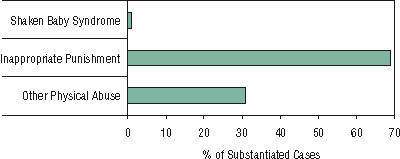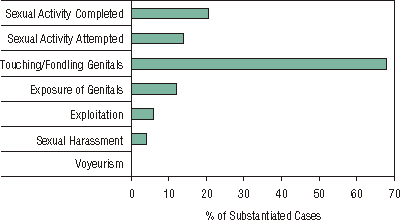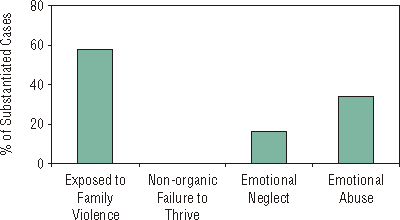ARCHIVED - The Canadian Incidence Study of Reported Child Abuse and Neglect
Spring 2001
Highlights
The Canadian Incidence Study of Reported Child Abuse and Neglect (CIS) is the first nation-wide study to examine the incidence of child maltreatment in Canada. Prior to this study, there was no central source of comprehensive, Canada-wide statistics on children and families investigated because of suspected child abuse and neglect. This has hampered efforts to develop effective policies, programs, and interventions. The CIS provides a snapshot of children who were reported to, and investigated by, child welfare services during a three-month period, from October to December 1998. The highlights presented below on physical abuse, sexual abuse, neglect, and emotional maltreatment are based on 7,672 investigations from 51 sites in all provinces and territories.
- In 1998, there were an estimated 21.52 investigations of child maltreatment per 1,000 children in Canada. Forty-five percent of these investigations were substantiated, 22% remained suspected, and 33% were found to be unsubstantiated.
- Child maltreatment investigations were divided into four primary categories: physical abuse (31% of all investigations), sexual abuse (10% of all investigations), neglect (40% of all investigations), and emotional maltreatment (19% of all investigations).
- Thirty-four percent of the physical abuse investigations were found to be substantiated. This compares with 38% for sexual abuse, 43% for neglect, and 54% for emotional maltreatment.
- Substantiated cases of physical abuse consisted of:
- Inappropriate punishment (69% of physical abuse cases)
- Shaken Baby Syndrome (1%)
- Other forms of physical abuse (31%)
- The most common forms of substantiated sexual abuse included:
- Touching and fondling of the genitals (68% of sexual abuse cases)
- Attempted and completed sexual activity (35%)
- Adults exposing their genitals (12%)
- The most common forms of substantiated neglect included:
- Failure to supervise leading to physical harm (48% of neglect cases)
- Physical neglect (19%)
- Permitting criminal behaviour (14%)
- Abandonment and educational neglect (12% and 11% respectively)
- Substantiated cases of emotional maltreatment included:
- Exposure to family violence (58% of emotional maltreatment cases)
- Emotional abuse (34%)
- Emotional neglect (16%)
The Canadian Incidence Study of Reported Child Abuse and Neglect (CIS) helps to fill a nation-wide need for accurate data on child maltreatment. Among the most thorough of its kind in the world, this study provides detailed estimates of the scope and characteristics of child abuse and neglect across Canada.
The CIS was conducted by the Bell Canada Child Welfare Research Unit at the Faculty of Social Work, University of Toronto, through funding from Health Canada. The CIS had the full participation of all provincial and territorial governments. Four provinces (British Columbia, Ontario, Quebec, Newfoundland) provided additional funds to increase the sample size in their jurisdiction. The study's aims were as follows:
- To examine the rates of investigated physical abuse, sexual abuse, neglect, and emotional maltreatment, as well as multiple forms of maltreatment;
- To examine the severity of maltreatment as indicated by duration and physical and emotional harm;
- To examine selected determinants of health for investigated children and their families; and
- To monitor short-term investigation outcomes, including substantiation rates, out-of-home placement, use of child welfare court, and criminal prosecution.
Methods
The CIS captured information about children and their families as they came into contact with child welfare services over a three-month sampling period, from October to December 1998. Each province and territory is represented in the study, as are aboriginal child welfare agencies. A multi-stage sampling design was used, first to select a sample of child welfare offices across Canada, and then to select cases within these offices. Fifty-one sites, including three aboriginal agencies, were selected from a pool of 327 child welfare service areas in Canada, all but four being randomly selected.
Information was gathered on all investigated cases of child maltreatment at the study sites. The CIS included 22 forms of maltreatment under four main categories: physical abuse, sexual abuse, neglect, and emotional maltreatment. The final sample of 7,672 child maltreatment investigations was used to derive national estimates of the annual incidence of investigated child maltreatment in Canada.
When interpreting these results, it is important to realize that they come from a sample of child maltreatment cases that were investigated by child welfare workers. The study does not include the following:
- cases investigated only by the police;
- cases known to other professionals but not reported to child welfare;
- cases of child maltreatment that are known by the larger community and not reported;
- unknown cases.

Thus, the CIS estimates represent a portion of all child maltreatment occurrences.
Finally, it is important to note that while the sample is large, the data are national in scope and cannot be used to determine provincial or territorial rates of child maltreatment.
Results
In Canada, there were an estimated 21.52 investigations of child abuse and neglect per 1,000 children in 1998. Of these, 9.71 were substantiated (i.e. confirmed or verified), 4.71 were suspected but not confirmed and 7.09 were unsubstantiated (i.e. sufficient evidence existed to conclude that maltreatment had not occurred). Each of the four categories of substantiated child abuse and neglect are described in the following paragraphs.
Physical Abuse
Physical abuse is the deliberate application of force to any part of a child's body, which results or may result in a non-accidental injury. This may involve hitting a child a single time or it may involve an ongoing pattern of incidents. Physical abuse may also include shaking, choking, biting, kicking, burning, or poisoning a child, holding a child under water, or any other harmful or dangerous use of force or restraint. Most child physical abuse is associated with physical punishment or is confused with child discipline.
The study classified physical abuse into three forms. The majority (69%) of the substantiated reports of physical abuse involved inappropriate punishment while other forms of physical abuse accounted for almost one-third (31%) of the cases. Shaken Baby Syndrome accounted for 1% of substantiated cases1. Taken together, physical abuse was the primary reason for investigation in 31% of all referrals to child welfare services. Thirty-four percent of these cases were substantiated.

Sexual Abuse
Child sexual abuse occurs when an adult or youth uses a child for sexual purposes. Sexual abuse includes fondling, intercourse, incest, sodomy, exhibitionism, and commercial exploitation through prostitution or the production of pornographic materials.
The CIS tracked seven forms of sexual abuse. Touching and fondling genitals was the most common form of substantiated child sexual abuse, occurring in 68% of cases. Attempted and completed sexual activity accounted for over one-third (35%) of all substantiated reports. Adults exposing their genitals to children was reported in 12% of cases. Sexual exploitation (6%) and sexual harassment (4%) were less common forms of child sexual abuseFootnote 1. There was an insufficient number of cases of voyeurism to permit estimates of this form of abuse. In all, sexual abuse was the primary reason for investigation in 10% of all child maltreatment referrals. Thirty-eight per cent of these cases were substantiated.

Neglect
Child neglect occurs when a child's parents or caregivers do not provide the requisite attention to his or her emotional, psychological, or physical development. Unlike abuse, which is usually incident specific, neglect often involves chronic situations that are not as easily identified.

The CIS tracked eight forms of neglect. Failure to supervise leading to physical harm represented 48% of the substantiated cases. Physical neglect (19%), permitting criminal behaviour (14%), abandonment (12%), educational neglect (11%), and medical neglect (9%) were next in order of percentage. Failure to provide necessary treatment (2%) and failure to supervise leading to sexual harm (5%) were much less commonFootnote 1. In total, neglect was the primary reason for investigation in 40% of all cases. Of these, 43% were substantiated.
Emotional Maltreatment
Emotional maltreatment involves acts or omissions by parents or caregivers that cause or could cause serious behavioural, cognitive, emotional, or mental disorders. It can include verbal threats, socially isolating a child, intimidation, exploitation, terrorizing, or routinely making unreasonable demands on a child.
The CIS tracked four forms of emotional maltreatment. The most common form was exposure to family violence (58%). This was followed by emotional abuse (34%) and emotional neglect (16%)Footnote 1. Non-organic failure to thrive occurred too infrequently to be estimated in the study. Emotional maltreatment was the primary reason for investigation in 19% of all cases. Of these, 54% were substantiated (the highest percentage out of all four categories of maltreatment).

Impact
The impact of the Canadian Incidence Study of Reported Child Abuse and Neglect will be far reaching. The data from the study will help us understand the occurrence of child maltreatment and the characteristics of affected children and families. The study is also the first step in the development of a national surveillance system on child maltreatment, which will provide a basis for the identification and analysis of trends regarding child abuse and neglect. The resulting information will contribute to effective public policies and programs for children and youth at risk of maltreatment.
Further Information
For copies of the reports, Canadian Incidence Study of Reported Child Abuse and Neglect: Final Report and Child Maltreatment in Canada : Selected Results from the Canadian Incidence Study of Reported Child Abuse and Neglect, please contact the following:
National Clearinghouse on Family Violence
A.L. 1907D1
7th Floor, Jeanne Mance Bldg.
Tunney's Pasture
Ottawa, Ontario
K1A 1B4
Telephone: 1-800-267-1291 or (613) 957-2938
Fax: (613) 941-8930
Web Site: www.hc-sc.gc.ca/nc-cn
This is but a sample of the data collected through the CIS. For more information on the study please contact the following:
Child Maltreatment Division
A.L. 0701D
HPB Bldg #7, Tunney's Pasture
Ottawa, Ontario
K1A 0L2
Telephone: (613) 957-4689
Fax: (613) 941-9927
Web Site: www.phac-aspc.gc.ca/cm-vee
- Footnote 1
Because multiple forms of a given category of maltreatment were sometimes reported, the individual forms add up to more than 100%.
- Footnote *
Trocmé N, MacLaurin B, Fallon B, et al. Canadian incidence study of reported child abuse and neglect: final report. Ottawa, Ontario: Minister of Public Works and Government Services Canada, 2001.
